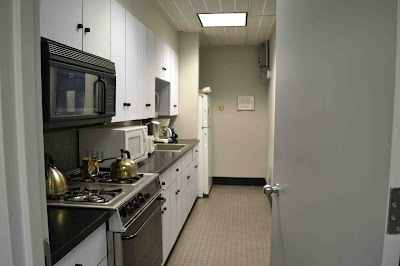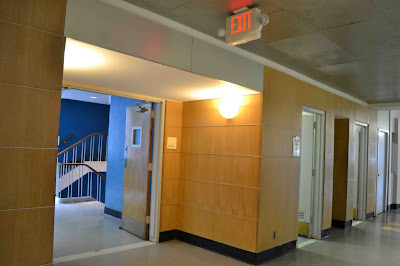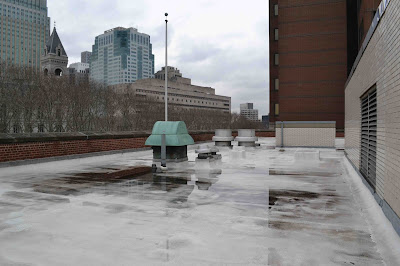In fact, would you like to see much of this library that the public doesn’t generally get to see?
. . . That the BPL would probably prefer the public not see?
Here are pictures of the library, including what the public never gets to see, taken on a private tour (3/26/2015) taken of the library when it was closed. The tour occurred after Citizens Defending Libraries advocated for such a tour making the point that it was ridiculous for the public to be selling off a very valuable asset essentially sight unseen, the public wearing a metaphorical blindfold.
Library administration officials working with NYC real estate development officials to transform this library into a juicy hand-out to a connected developer try to denigrate the library, saying it is worthless, unusable space in very poor condition. We think otherwise.
We think the library is very valuable, and that, conversely, the BPL would subjecting the public to huge losses selling it.
We think that, as the photos show, it’s a sturdy library with a history. It was designed by Francis Keally, who designed the other central destination library in Brooklyn at Grand Army Plaza. To wit:
The Keally library is 63,000 feet of extraordinarily serviceable (and adaptable) square feet. That includes two half-floors of underground space that, similar to the 42nd Street Central Reference Library, were set up to hold books for easy on-the-spot retrieval. Echoing the 42nd Street library, an “automatic conveyor belt” helped deliver books more efficiently. To say that the building is sturdy is an understatement: When it was built, it was built with space set aside for a bomb shelter with the thought that people could go there to be protected against a nuclear attack.(SEE: Monday, June 15, 2015, Municipal Art Society, Once Venerable, Becomes Platform For Disseminating Misinformation Promoting Development, In this Case Backing Library Sales and Shrinkage.)
The air-conditioned building was built in 1962 (at a cost in today's dollars of about $20 million) and opened with a collection of 90,000 volumes. In 1991 it was enlarged and upgraded (at a cost in today's dollars of about $10 million). Then, additionally, a reclamation of the space people once thought might be used as a bomb shelter added even more space for books.
The library was built intending to serve all of Brooklyn and, being the only library addressing certain business needs and functions (“the only library in the city” for such needs), was intended to draw patrons not only from all of Brooklyn but Manhattan, including lower Manhattan’s Wall Street right “across the river.” As well as accommodating staff according to earlier, kinder standards the BPL does not now want to meet, the building has rooms used as conference rooms and more rooms that could be similarly used. Its construction involved “special workrooms for business researchers,” including cubicles. Wanting to give the library over to development (secretly since about 2007) the BPL has not adapted or made these spaces available for the kinds of uses the public would likely appreciate.
If you want to refer to floor plans (Citizens Defending Libraries got them released to) when reviewing these photos there are here: Floor Plans of the Brooklyn Heights Library Considered In Light of the Library's Proposed Sale and Shrinkage.
Replacing the physical building alone would cost $60 million, perhaps more, and then there is the land and development rights associated with future expansion that would have to be paid for to duplicate what the public now owns.
What’s missing in these photos are pictures of the library auditorium which is open to the public at various times for all sorts of functions.
One sadness is how the BPL has, readying for the sale it is so very keen on, been focusing on emptying the library of books. More Photo's (pre-tour) focusing on that (also in other libraries targeted for sale) are available here: Saturday, September 14, 2013, Empty Bookshelves As Library Officials Formulate A New Vision of Libraries: A Vision Where The Real Estate Will Be Sold Off and Saturday, February 14, 2015, "Fully stocked and overflowing shelves of children books"?- The Brooklyn Heights Library According to BPL's Taina Evans. Really?
The photos provided here were taken on a private tour when the library was closed that was given for members of the “Community Advisory Committee” constituted of members who were pre-screened by library administration officials interested in having members sympathetic to a sale. A few of them actually aren’t. And we are pleased to have these pictures although neither Citizens Defending Libraries, nor the actual public has not been invited on such tours.
If this building is such bad shape that it needs to be sold ("dilapidated" was one headline BPL PR people fed the Daily News) then probably 85-90% of the houses of worship in Brooklyn similarly need to be sold for the same reasons. In other words: NOT!
More pictures (but only the public areas) appeared in this article: Tuesday, October 7, 2014, The Public Loss of Selling And Shrinking the Brooklyn Heights Library- How Great Will the Loss Be? Let's Calculate.
Should we start with some underground space purposed to keep books for ready retrieval? We also have these and even more photos also up on Flickr.
In no particular order.*
(* NOTE: One person who was in the way of the camera in a number of the pictures taken, Deborah Hallen, expressed a desire not to viewable in the images. We could have used Photoshop to leave blankness or oddly shaped blurs in certain of these pictures to accommodate that preference, but given how time consuming that would have been and the public interest imperative in making these photos sooner rather than later, we felt it was not worth obscuring this person's participation in what ought to be a very public process.)
 |
| Working when the library is closed |
 |
| Give the views to the luxury condominium owners instead? |



























































































No comments:
Post a Comment